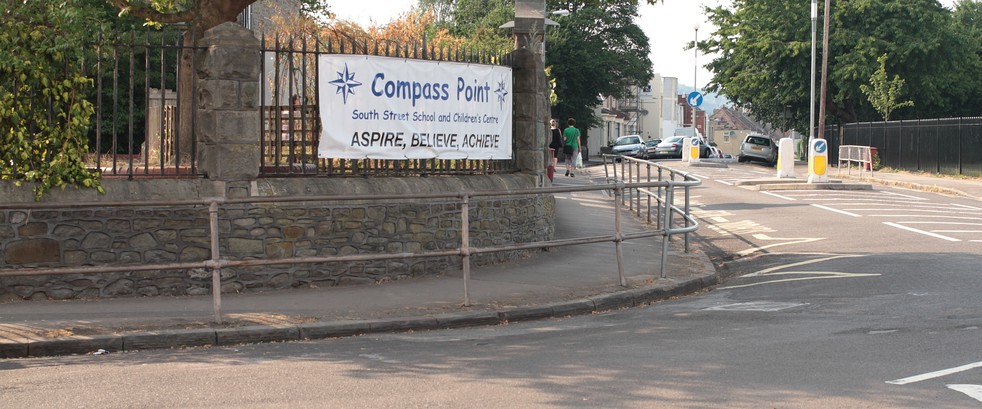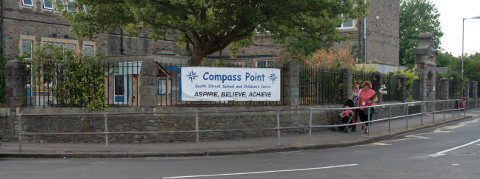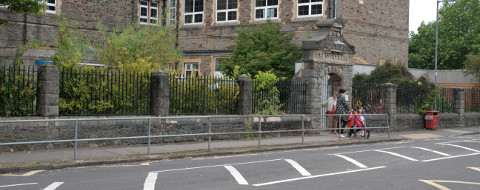Pedestrian Guardrails

Guardrails are barriers placed at the edge of pavements to stop pedestrians walking into the road. In the last 10 years, guardrails have become less popular because there is no clear evidence for a safety benefit, and they have a negative impact on accessibility and the feel of towns and cities for pedestrians.
Disadvantages
- Motor vehicle drivers cannot see pedestrians as easily through guardrailing, especially child pedestrians. This means motor vehicle drivers are less prepared to stop for pedestrians if they walk into the road at a crossing point
- However, the view of pedestrians will be obscured to a much lesser extent if 'Visirail' is used. Visirail uses a different design which allows drivers to see through gaps in the railings better
- Prevents free movement of pedestrians around towns and cities, "which creates an unpleasant feeling of restraint" (CIHT, 2010)
- Guardrailing is intrusive and detrimental to the look and feel of streets
- Pavement width is reduced when guardrailing is installed
- Some pedestrians may climb over guardrailing, which creates a further safety risk
- Cyclists could become crushed against guardrailing if they collide with a motor vehicle
- Guardrailing is often damaged by motor vehicles or heavy goods vehicles, so it can be very expensive to maintain

Restrictions
- The pavement must be wide enough to accommodate the guardrail and pedestrians.
There's also some general restrictions to note for all schemes
Advantages
- Where children are frequently present, guardrailing can be useful in short sections e.g. at school or park exit points
- Might be effective at channelling pedestrians towards designated crossing points
- Prevents pedestrians accidentally straying into the road (e.g. drunk intoxicated pedestrians)

Effectiveness
Overall, evidence about guardrails shows they provide no safety benefit. Studies concluded there was very little difference in collision numbers between sites with or without guardrails. This applied to both vehicle and pedestrian collisions.
Guardrails can be useful to channel pedestrians to crossing points, and stop people accidentally walking into the road. However, the evidence shows these benefits do not outweigh other issues created by guardrails. Guardrails obscure the view of pedestrians from motorists, which prevents motorists taking action to avoid a collision.
Road designs which remove clutter such as guardrails from streets are increasingly recognised for the positive effect they have on the street appearance and feel. This encourages sustainable transport modes, such as walking and cycling.
To improve pedestrian safety, other measures which have proven safety effects should be used first. This could be a reduction in the speed limit in conjunction with traffic calming measures. An exception to this could be where a pathway meets a road, from an alleyway, or school entrance for example - in these instances, a small section of guardrail opposite the pathway prevents pedestrians (especially children) continuing forward into the road.
Advanced information
Crashes
Chatterjee, Hall and Taylor (1996) suggests there is little difference in safety effects between sites with or without guardrails, however this evidence was only focussed on 3 or four arm junctions, and the article age undermines credibility.
Zheng & Hall (2003) produced a relatively robust study, which found positive effects of guardrails in London, however this research has been superseded by a study from the same research unit (Southampton University) in 2009, which is outlined in LTN 2/09. LTN 2/09, published by the Department for Transport, informed a large proportion of the findings here, as the research methodology was the strongest, with the greatest number of study sites.
References
Local Transport Note 2/09 (2009) Pedestrian Guardrailing. Transport Research Group, Southampton University (Report for Department for Transport).
Chartered Institute for Highways and Transportation (2010) Manual for Streets 2. CIHT: London.
Taylor, M., Hall, R., Chatterjee, K. (1996) Accidents at 3-arm traffic signals on urban single-carriageway roads (TRL135). Transport Research Laboratory. Crowthorne, UK.
Zheng and Hall (2003) Pedestrian Guard Railing: A Review of Criteria for Installation. Transport Research Group, Southampton University (Report to Transport for London).




